Table of Contents
ToggleThe Evolution of the Athlete Development Tracking System (ADTS™)
In the world of sports, capturing athlete evaluation data has been possible since the 1980s, but it was a costly endeavor. The most practical medium back then was paper, given the high expenses associated with digital storage, entry, and data extraction. Fast-forward to today and these limitations have virtually disappeared.
Thanks to technological advancements, data entry and extraction can be automated, and storage is nearly limitless. This transformation opens the door to enhanced athlete development, moving us from paper tracking to sophisticated, integrated online systems.
Let’s dive into how this evolution has shaped the Athlete Development Tracking System and the numerous benefits of going digital.
The Era of Paper Tracking: Early ADTS™ Methods
Before digital systems, athlete evaluation data was meticulously recorded on paper and filed away in cabinets. This process, while functional, came with significant drawbacks:
- Data Loss: Paper files can be easily lost or damaged, compromising athlete progress records.
- Limited Accessibility: Retrieving data from a filing cabinet is inefficient and cumbersome.
- Resource Intensive: Extracting meaningful insights from large volumes of paper records is time-consuming, especially as athlete numbers grow.
Despite its limitations, paper tracking served a purpose. However, today’s ADTS™ options offer more efficient, reliable, and scalable solutions. Let’s explore the advantages of taking your ADTS™ online.
The Digital Transformation: Why Go Online with ADTS™?
What is an Athlete Development Tracking System (ADTS™)?
An Athlete Development Tracking System (ADTS™) is an online platform designed to track and enhance athlete progress through continuous evaluation. It enables organizations to create, deploy, measure, and adjust development programs for long-term athlete success.
Core Components of an ADTS™
An effective ADTS™ consists of four main components: Create, Deploy, Measure, and Adjust. Each step plays a critical role in optimizing athlete development programs.
1. Create
The Create stage is the foundation of an Athlete Development Tracking System (ADTS™). How you design and format your athlete development programs is critical, as it determines the metrics you’ll track in the Measure component of the ADTS™.
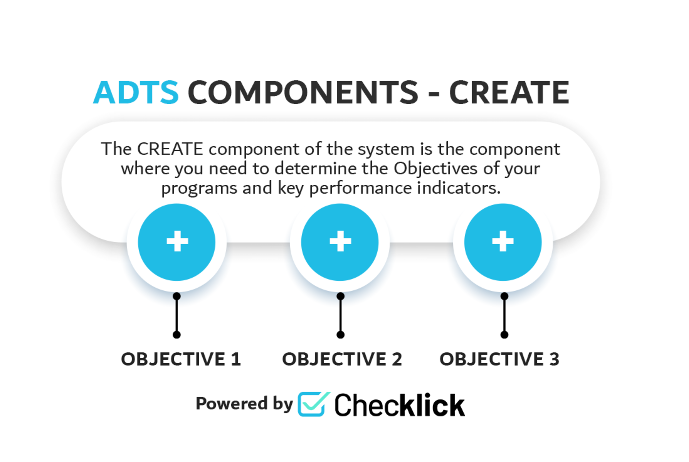
Creating an athlete development program is a significant task requiring expertise in your sport. These resources may range from expert coaches to knowledgeable volunteers. Canada, a leader in the Long Term Athlete Development (LTAD) methodology, demonstrates that building effective programs takes years of dedication, resources, and refinement.
In the Create stage, it’s essential to set clear objectives and define your Key Performance Indicators (KPIs). Aim for one primary objective, or no more than three, to maintain focus. Once you establish these goals, decide which skills to track and how to measure them. For instance, you could use a quantitative 1-10 scale or a simple “completed” marker for skills tracking on your checklist.
Different program structures are necessary depending on the athlete’s level. For recreational programs, participation might be the main focus, while high-performance programs may require more precise skill development measurements.
While creating a program can be complex, avoid over-analyzing. Adopting a Minimal Viable Product (MVP) mindset from the tech industry can streamline this process. This approach, known in ADTS™ as a Minimal Viable Athlete Development Program (MVADP), encourages developing an early version of your program and allowing user feedback to guide further refinement. This lean strategy conserves resources and prevents excessive changes down the line.
2. Deploy
The Deploy phase in an Athlete Development Tracking System (ADTS™) is all about putting the programs created in the earlier stage into action. This step involves distributing the skill checklists and other program materials to your training centers, coaches, or instructors. While a simple spreadsheet can suffice, using an online system specifically designed for tracking and distributing these materials can greatly enhance efficiency—especially if you’re managing multiple training centers.
An online system allows seamless distribution, accessibility, and real-time data collection, making it easier to monitor program implementation across various locations. The key is to ensure that these programs are accessible to those who will be directly engaging with them.
Finally, don’t overlook the value of feedback. Insights from training centers, coaches, and athletes are invaluable for refining your programs. This feedback loop is crucial for making continuous improvements that ensure the program remains relevant, effective, and tailored to the needs of its users.
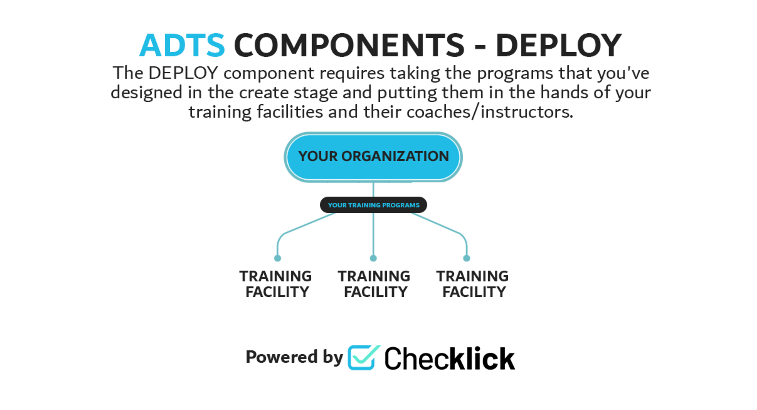
3. Measure
Once the program is in motion, the Measure stage evaluates its success. Here, coaches complete skill checklists and provide feedback, which can be centralized in an online ADTS™ for real-time analysis. This stage involves ongoing tracking of program objectives and KPI fulfillment, and insights on athlete progress can be gathered from the data.
Effective measurement answers critical questions:
- Are program objectives being met?
- Are KPIs yielding the expected insights?
- Have objectives evolved, necessitating adjustment?
Feedback from coaches and athletes during this stage is essential to fine-tune the program continuously.
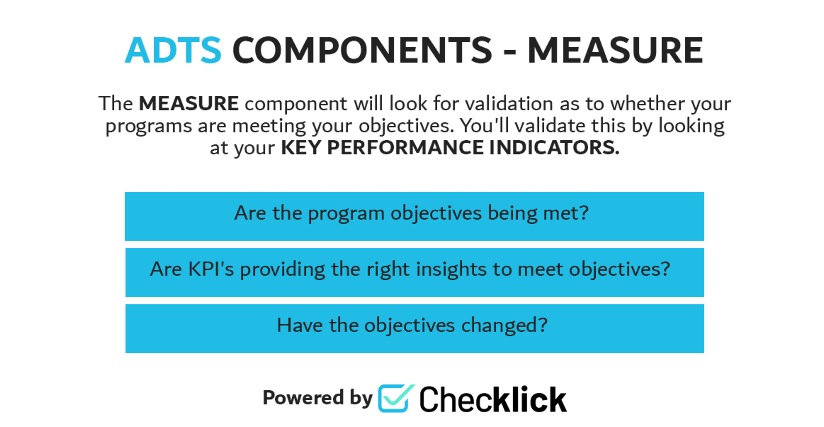
4. Adjust
The final stage, Adjust, focuses on fine-tuning programs based on feedback and data collected. If data points do not align with your objectives, it may be time to revisit KPIs or refine specific skill assessments. A well-designed ADTS™ should simplify this adjustment process, ideally offering data exports or infographics for easy interpretation.
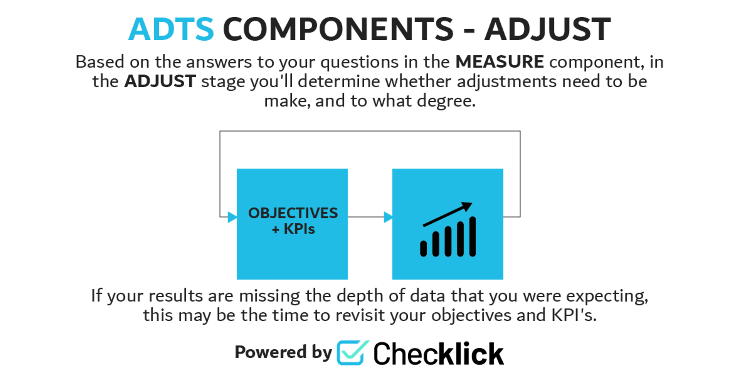
Optimizing ADTS™ for Multi-Center Deployment
Large sports organizations often deploy programs across multiple training centers, each with numerous coaches and athletes. An ADTS™ simplifies this by centralizing deployment and measurement in a way that ensures consistency and accuracy, regardless of the organization’s size.
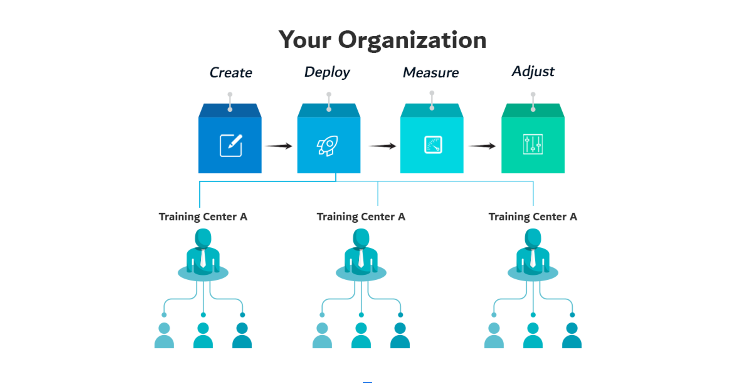
Your Organization’s Role vs. Training Center’s Role
The Deploy state of the ADTS™ is where both your organization and your training centers bear responsibilities. The responsibilities can be described in the diagram below;
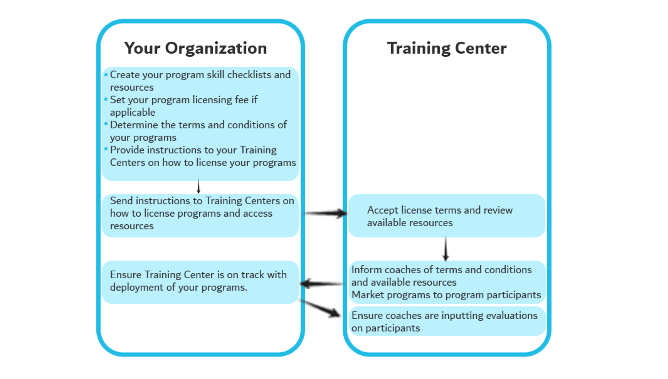
Deploy and Measure Feedback Loop in ADTS
In the deployment stage of the Athlete Development Tracking System (ADTS), information flows outward. It starts from your organization, moves to training centers, then to coaches, and finally reaches athletes or program participants.
In the Measure stage, information flows in the opposite direction. It starts with the program participants, moves back to coaches, continues to training centers, and ultimately reaches your organization.
This flow creates a continuous feedback loop, illustrated in the diagrams below.
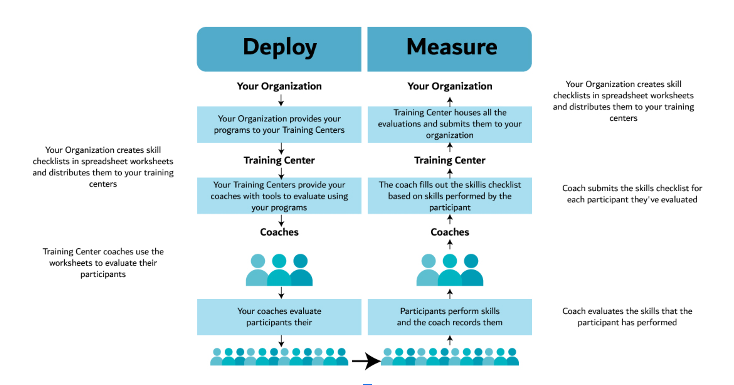
Administering the Deploy and Measure Feedback Loop
Steps to Distribute Programs
- Build a Program Checklist: Use a spreadsheet to create a checklist that covers all the skills for the program.
- License Programs: Define the terms under which training centers can access and use your programs.
- Distribute Checklists: Training centers provide licensed program checklists to their coaches.
Steps to Collect Evaluations in the Measure Stage
- Enter Participant Evaluations: Coaches record participants’ evaluations on the provided spreadsheets.
- Store Evaluation Sheets: Coaches submit the evaluation spreadsheets to their training center administrators.
- Submit to Organization: Training centers send the completed evaluation spreadsheets to your organization.
An Efficient Deploy and Measure Feedback Loop
To improve this process, an efficient ADTS should organize both the Deploy and Measure stages.
Efficient Deploy Stage
In the Deploy stage, your organization’s primary effort should focus on creating the program. Ideally, the rest of the distribution process is automated. A centralized digital system for program distribution can replace manual methods like paper or spreadsheets, saving time and reducing errors.
Efficient Measure Stage
In the Measure stage, an effective ADTS should offer instant feedback. When a coach enters an evaluation, that information should immediately be accessible to your organization, eliminating delays.
Below are diagrams comparing an inefficient and efficient Deploy and Measure feedback loop.
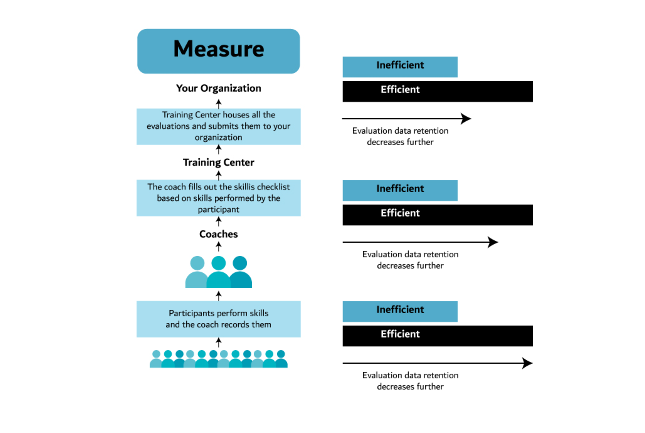
Impact of Efficient vs. Inefficient Feedback Loops
An inefficient feedback loop can lead to:
- Significant Lag Time: Information is delayed at each stage as it moves up the chain.
- Risk of Data Loss: The further data travels manually, the higher the chance for information to be lost or miscommunicated.
By contrast, an efficient feedback loop minimizes delays and reduces the risk of data loss. In an ideal setup, when a coach evaluates a participant, the information instantly reaches your organization.
This instantaneous data flow eliminates latency and ensures that each skill evaluation reaches the organization without delay, resulting in a smooth and highly effective Deploy and Measure feedback loop.
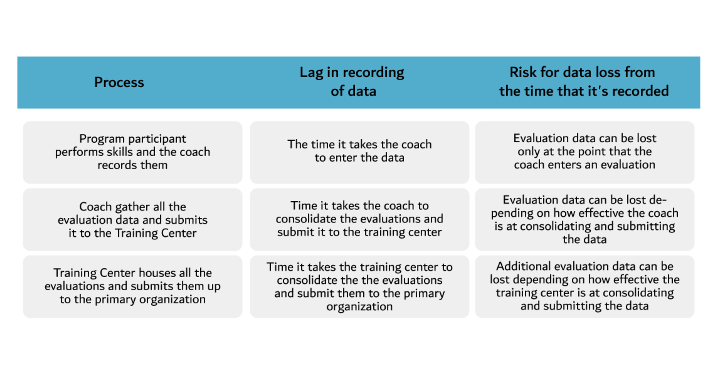
Who Benefits from an ADTS™?
Both small and large sports organizations stand to benefit from implementing an ADTS™.
Single Training Center Organizations
Smaller organizations with a few coaches can still achieve tremendous value from an ADTS™, as it provides structured, measurable insights into program effectiveness.
Organizations Licensing Programs to Multiple Centers
Large organizations benefit from a centralized ADTS™, which facilitates scalable program management, licensing, and data collection across multiple locations. If you are deploying programs to multiple training centers, a sufficient ADTS™ interface allows you to perform multiple functions with a single action.

Is an ADTS™ Right for Your Organization?
An ADTS™ is particularly valuable if your organization meets any of the following criteria:
- You need structured athlete development programs.
- You report athlete statistics for funding.
- You aim to improve connections with training centers.
- You’re looking for ways to generate new revenue streams.
Training centers also benefit from an ADTS™, as it provides a professional, organized system to track and report athlete progress, which can enhance their credibility and operational efficiency.
The Value of an ADTS™ for Training Centers
An Athlete Development Tracking System (ADTS™) offers significant benefits for training centers, enhancing both their operational efficiency and their ability to deliver high-quality programs. Here’s how an ADTS™ can add value to training centers:
Professional Image: By using an organized and standardized system for delivering athlete development programs, training centers portray a professional image to their customers, setting them apart in a competitive market.
Time Efficiency: An ADTS™ centralizes all athlete evaluation data, allowing easy access to records from year to year. This saves time by reducing the need to manually locate and compile data, enabling coaches to focus on athlete development.
Contribution to Program Ecosystem: Training centers using an ADTS™ become a vital part of a broader program ecosystem. Their feedback and data improve the quality of the programs provided, enhancing the quality and discipline of the coaching.
Progress Tracking for Parents and Athletes: An ADTS™ allows parents, athletes, and participants to easily track progress over time, from a young age through advanced levels, making it a valuable tool for long-term development.
Quantitative Program Measurement: With an ADTS™, training centers can measure the effectiveness of their programs quantitatively, enabling them to make data-driven improvements and showcase their success to stakeholders.
By implementing an ADTS™, training centers not only manage operations but also enhance the athlete experience, helping to ensure long-term success for both the center and its athletes.
Creating a Profitable Business Model with ADTS™
One of the significant advantages of implementing an Athlete Development Tracking System (ADTS™) is the ability to establish a consistent revenue stream. However, to generate sustainable income, the athlete development programs you offer must deliver substantial value to training centers and their athletes.
How Do You Create Value in Your Athlete Development Programs?
Before diving into the business model, it’s essential to understand that a solid business model is only achievable if training centers recognize the value in your offerings. Here are a few ways to create that value: Leverage Your Expertise for Credibility Use your in-house expertise to design effective athlete development programs that meet training centers’ needs, establishing credibility and making it easier for organizations to trust and adopt your ADTS™. Provide Comprehensive Resources Offer continuous support resources, such as training materials and best practice guides, to ensure long-term success and smooth adoption of your ADTS™ across the ecosystem of administrators, coaches, and participants. Keep Programs Current with the ADTS™ Framework Collect real-time feedback from coaches, athletes, and administrators using the ADTS™ framework to keep your programs relevant, effective, and aligned with athletes’ evolving needs.Types of Business Models for Your ADTS™
Selecting the appropriate business model is crucial when developing a source of income for your athlete development initiatives. There are different ways in which you can structure the business model. We recommend choosing the most viable business model for your athlete development programs, and there are several factors. Depending on your organization’s size and requirements, there are several options. The following are ADTS’s top three business models:
Per Participant Fee
This model involves charging a fee based on the number of athletes enrolled in your programs. While this approach allows scalability, it can be more challenging to manage, especially for larger training centers or organizations with fluctuating participant numbers.
Per Training Center Fee
A flat fee charged per training center or organization is one of the easiest models to manage. It provides predictable, steady income and is ideal for organizations with multiple locations or training centers. The per-training center model simplifies administration and allows for easy forecasting of revenue.
Per Coach/Instructor Fee
This model charges based on the number of coaches or instructors using the ADTS™ platform. It’s a great option for organizations with a large staff of coaches who will be using the athlete development tracking system regularly. This model ensures that the system is accessible to all involved in the development of athletes.
We recommend charging upfront for all models, as you provide resources and support from the moment users begin using your programs. Collecting fees in advance ensures you can sustain your programs and maintain a healthy cash flow.
Keep in mind that the per-participant model is the most challenging to manage, while the pre-training center model is the easiest to implement.

Final Thoughts: ADTS™ for the Future
Today, an Athlete Development Tracking System is more than just a tool, it’s a strategic asset that empowers organizations to enhance athlete performance, manage evaluation processes, and gather insightful data to shape future programs.
Whether you’re a small club or a large organization, an ADTS™ can centralize and elevate your athlete development process, making it easier to adapt, grow, and support athletes at every stage of their journey.
By embracing a digital ADTS™, you’re not just tracking athlete progress, you’re building the foundation for long-term athletic excellence.
Start your free trial today and see how Checklick can make athlete development more efficient, measurable, and impactful. Don’t just track progress, drive it with Checklick!
